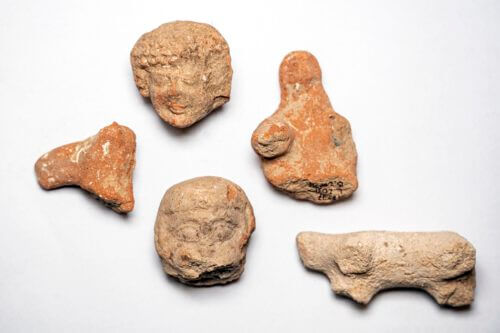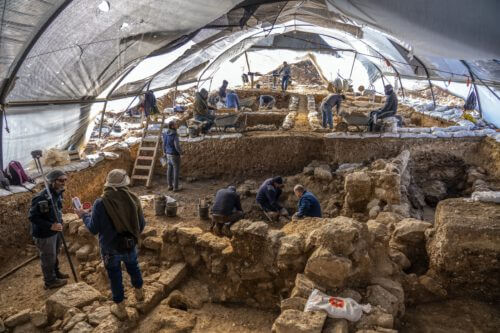The site, which contains more than 120 seal impressions on jars with ancient Hebrew writing, was discovered near the US Embassy in Jerusalem. which bear the names of the senior officials and capitalists of the Kingdom of Judah in ancient Hebrew script

About 2,700 years ago, the Kingdom of Judah was prepared for what challenge in the Arnona neighborhood in Jerusalem, and is this related to a dramatic historical event? A significant state storage center from the days of Kings Hezekiah and Manasseh - from the end of the 8th century to the middle of the 7th century BC has been uncovered these days in archaeological excavations in the Arnona neighborhood in Jerusalem, near the residence of the American Embassy. The excavation is being managed by the Antiquities Authority with funding from the Israel Lands Authority and through the Moriah company, in preparation for the establishment of a new neighborhood.
On the site, an unusual structure was revealed in its size and character for the period, built of huge ashlar stones, with double and triple walls. More than 120 imprints were also uncovered on the handles of storage jars, many of which bear the inscription 'Lamelch (for the king)', names of cities, and names of those who were, apparently, the senior clerks and owners of the wealth of the First Temple, in ancient Hebrew script. This is one of the largest and most important sets of impressions discovered in the archeology of Israel.
According to Naria Sapir and Natan Ben-Ari, the managers of the excavation on behalf of the Antiquities Authority, "This is one of the most significant discoveries from the period of the kings in Jerusalem in recent years. At the site we excavated there was a governmental activity, which managed the concentration of the food stock and directed it, perhaps also as a storage for days of scarcity. It seems that taxes were collected at this site in an orderly state manner: an activity of collecting agricultural produce is evident here, as well as the production of wine and olive oil. The site dominates an extensive agricultural area, where olives and vines are planted, and where wine-making pits and agricultural industry facilities were discovered. It dates to a period of many upheavals and events known from the Bible, including the Assyrian conquest - under the command of King Sennacherib and in the days of King Hezekiah. It is not impossible that the economic preparation is related to these events. However, the excavation reveals that the site continued to exist even after the Assyrian occupation. It is interesting to know that on the handles of the storage jars are some of the names of the senior officials and capitalists of the kingdom of Judah - Nachem Abdi, Nachem Tzaliyahu, Shloem Elnathan, Tzipan Avmaetz, Shabnia Azaria, Shalom Acha and Shabna Shahar. These names appear on the handles of storage jars at various sites all over the Kingdom of Judah, which indicates the status of the owners of the imprints: according to information, these are the senior clerks, who were in charge of areas
certain in the economy of the time, or perhaps - the capitalists of the past, those who owned large agricultural areas and drove the economy of the estates, and who owned a private stamp.
According to Naria Sapir and Natan Ben-Ari, the managers of the excavation on behalf of the Antiquities Authority, the many seal impressions indicate directly and beyond any doubt that in the late days of the Kingdom of Judah, governmental activity took place in this area, south of the City of David. It is even possible that this administrative activity is related to the site previously uncovered in the nearby Ramat Rachel, which has been identified, with a great degree of certainty, as the palace of the kings of Judah and/or as an administrative center.

Among the seal prints were discovered the machine prints with the name "King". This stamp is characterized by the symbol of a hot wheel, with wings outstretched on its sides. Above the hot wheel appears the word 'for the king' in ancient Hebrew script, and below it - the name of one of four cities in the Kingdom of Judah: 'Hebron', 'Shuka', 'Zif' and 'Mashat'. According to Sapir and Ben-Ari, "Hebron, Ziph, and Shacha can be identified with a great degree of certainty with ancient cities in Judah, which were located in the area of Mount Hebron, while the identification of Meshet is disputed."
At a certain point, for reasons that are not understood, the buildings were covered with a huge pile of flint stones - like a kind of artificial hill rising to a height of about 20 meters from the surface, and its size extends over a wide area of about seven dunams (!). Even today, this huge pile of stones is visible from a distance and stands out in the surrounding hilly landscape. According to the researchers, "Majestic stone hills are known from a number of sites in Jerusalem from the end of the First Temple period, and therefore they have also fascinated and surveyed Jerusalem researchers since the beginning of archaeological research in the area. And yet, the reason for investing the tremendous effort in piling them up over many dunams, remains an unsolved archaeological puzzle."
Another find that was discovered and sheds light on the character of the period, is a collection of figurines - figurines made of clay. According to archaeologists Sapir and Ben-Ari, "Some of the figurines are designed in the form of women and horsemen, and some in the figures of animals. These objects are usually interpreted as objects that were used for idol worship and foreign worship - a phenomenon that, according to the Bible, was prevalent in the Kingdom of Judah." The researchers add, "It turns out that a short period after the end of the site, with the destruction of the Kingdom of Judah in 586 BC, which is the year of the exodus to Babylon, the place was resettled, and administrative activity continued there. This time, there was a governmental activity in it that was related to the fall of Judah with the return of Zion, in 538 BC, and under the auspices of the Persian Achaemenid Empire that then ruled throughout the entire Ancient East and Central Asia."
According to Dr. Yuval Baruch, an archaeologist for the Jerusalem area at the Antiquities Authority, "it is the archaeological discoveries in the property that establish the site as a key - extremely important - site in the history of the Kingdom of Judah - in the period from the end of the Kingdom of Judah and the days of the return of Zion, a few decades after the destruction of the kingdom. This site joins a series of key sites
Others that were uncovered in the vicinity of Jerusalem and which were related to the centralized administrative system of the Kingdom of Judah, at its peak and at least until its destruction. The Antiquities Authority, together with the Israel Lands Authority, recognize the extraordinary importance of the site and its uniqueness, and are therefore working together to preserve parts of it and integrate them into the new neighborhood plan. This, as part of the trend led by the Antiquities Authority for sustainable development, which sees archeology as a resource that must be preserved and presented to the public as part of the values of the place, and not just as an academic-research field."

One response
Another proof. One of many, although this was not the intention of the diggers, because the people of Israel were, like all other peoples, even in the theological matter, i.e. zoomorphic and similar objects that clearly belonged to the Jewish population, and here, among other things, once again all the rebuke of the prophets of wrath seem to represent an unverified point of view clearly.